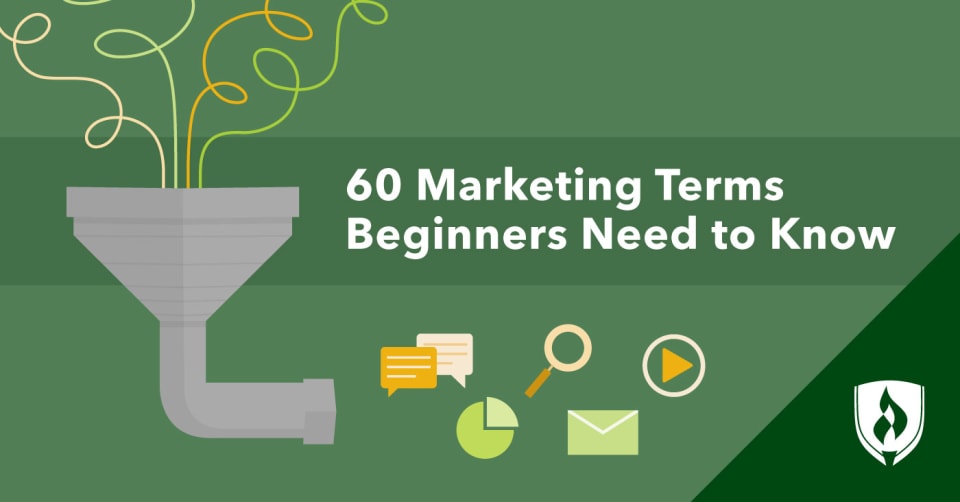
There’s nothing worse than being part of a conversation you don’t fully understand. When it comes to discussions about marketing, you can easily find yourself on the outside looking in. If you’re just trying to get up to speed in this field, terms and acronyms like “SEO”, “ROI” and “B2B” seem to come pouring out at a rate that’s enough to make your head spin. The list of need-to-know marketing terms and concepts continues to grow as time, techniques and technologies advance.
While there’s certainly a lot to take in, you don’t have to stay stuck wondering what everyone is talking about. To help, we rounded up a list of the most common marketing terms, abbreviations and concepts in use today. Additionally, understanding the fundamentals of marketing is essential in navigating the ever-evolving landscape of business promotion and customer engagement. Explore our article on "What Is Marketing?" to gain insights into the core principles and strategies driving successful marketing initiatives.
60 Useful marketing terms worth knowing
Ready to get up to speed? We’ve broken this list of marketing terms down into a few primary categories:
- Basic marketing terms
- Types of marketing
- Digital marketing terms
- Social media marketing terms
- Market research and analysis
Basic marketing terms
1. Lead
Leads are potential buyers who have engaged with a brand in the past and are likely to make a purchase in the future.
2. Content
Content is any piece of information that’s created to be viewed by an audience. This could include blog posts, email newsletters, social media posts, videos or even print brochures.
3. Infographic
Infographics are a type of content that presents statistics and other information in an easy-to-read, well-designed image.
4. Analytics
In marketing, analytics refers to the process of analyzing data to determine the return on investment of a particular marketing activity. Marketers may also use the term analytics to talk about the dashboard or system they use to review and track this data.
5. Brand
A brand is the way a company is perceived and experienced by potential customers. Pieces of a brand include its logo and other design elements, the voice it uses when interacting with customers and the target customers it’s known for serving.
6. Buyer persona
Buyer personas are the imaginary people marketers target when they design ads or create content like website copy. Although buyer personas aren’t real people, they are created based on data from actual consumers. These personas are then used to inform the audience, tactics and tone of the messages delivered.
7. Call to action (CTA)
A call to action is a prompt that encourages website visitors to take a certain action, such as subscribing to an email newsletter or submitting a contact form. CTAs are used to guide potential customers through the next step in a sales funnel.
8. Customer journey
The customer journey is a phrase that businesses use to describe the process from when a potential customer shows interest in a product or service to the point that the interaction is finished.
9. Case study
Case studies are a type of content that typically showcases a company’s work with a past customer, often with a heavy focus on statistics or other quantifiable data that help highlight how the company achieved the desired results.
10. B2B
This acronym is shorthand for business-to-business marketing. B2B companies are those that market their products or services to other businesses.
11. B2C
This acronym stands for business-to-consumer marketing. B2C companies sell their products or services directly to the end consumer.
12. Testimonial
A common element found in marketing materials, a testimonial is a person’s written or spoken statement explaining the value of a product or service. These often come from customers and are used to bolster the credibility of a marketing message.
13. Engagement
Engagement refers to the connection and relationship marketers build over time with their customers. In digital marketing, engagement can sometimes be measured as actions a visitor takes, such as clicking a link or commenting on a social media post.
14. Public relations (PR)
Public relations involves managing the spread of information about a company—whether good or bad. PR professionals work to spread positive news about their brand and minimize the impact of negative news.
15. Qualified lead
A qualified lead is the name of an individual that the marketing team has deemed to be a viable prospect for marketing their product; this is based on marketing efforts that have shown this individual has potential interest in the product.
16. Return on investment (ROI)
Every marketing campaign requires an initial investment of time and/or money. Return on investment is a metric that measures whether a campaign earned enough money to be worth the initial cost.
17. Sales funnel
A sales funnel refers to the buying journey new leads take before they make a purchase. The sales funnel includes several steps, from learning that a brand exists to becoming a loyal customer.
18. Testimonial
Testimonials are a type of social proof in which past customers make a positive statement about their experience with a brand.
19. Unique selling proposition (USP)
A USP is referring to what exactly makes your product stand out in comparison to the competition around it. This could be a unique feature, superior quality, a low price or even the ability to “bundle” with another product.
20. On-site content
All of the content that a company produces and shares on its own website. On-site content is produced to give a potential customer the best experience while they are searching for your product or service.
21. Off-site content
The content that is made away from a company’s home website, off-site content is designed to catch the eye of a potential customer and draw them to a company’s website, product or service.
22. Cold calling/emailing
A tactic used by salespeople to contact potential customers via phone or email with whom the company has had no previous contact.
23. Onboarding
Integrating a new employee or client into a company/organization by familiarizing them with your product or service.
24. Campaign
A campaign is a cohesive set of marketing activities designed to achieve a specific goal, like increasing sales for a certain product or spreading awareness of a new product feature.
25. Brand awareness
The extent to which potential customers are familiar with your company and the distinct images or qualities that are associated with what you are selling.
Types of marketing
26. Inbound marketing
This marketing method uses strategies like content marketing and social media marketing to attract new customers. Rather than pursuing customers with a hard sell, inbound marketers forge connections with people by meeting them where they’re at in the purchase process. Ideally, this approach draws them in to learn more about the brand. For example, a grill manufacturer is writing an article comparing the pros and cons of gas grills versus charcoal grills. This provides helpful information about a common topic of interest for prospective customers and may lead to more direct sales questions, e.g., “Which gas grill should I purchase?”
27. Outbound marketing
This traditional type of marketing seeks to get the attention of potential buyers by interrupting them in their daily lives using techniques like cold calls or direct mail campaigns.
28. Social media marketing
This digital marketing method uses social media channels to introduce potential customers to a brand and to gradually build a connection through regular interaction.
29. Email marketing
Email marketing is content sent via email to current or potential customers who subscribed to a marketing email list. Check your inbox—you’ve seen countless examples.
30. Content marketing
This marketing method focuses on creating relevant, consistent content to attract new leads and turn them into customers. Blog posts, email newsletters, vlogs and podcasts can all be pieces of a content marketing strategy.
31. Omnichannel marketing
Omnichannel marketing refers to the integration of all the various forms of marketing that a company uses to ensure that a customer has a consistent brand experience.
Digital marketing terms
32. Landing page
A landing page is a static, stand-alone website page that includes a strong call to action as part of a marketing campaign.
33. Chatbot
A chatbot is an automated tool found on many websites, typically used to help address common customer questions or concerns. They scan chat messages from customers to identify potential keywords and topics of interest and then relay pre-populated messages. Chatbots can escalate to a human representative as needed, often with additional context to help make those person-to-person conversations more efficient.
34. Keyword
Keywords are words or short phrases that users enter into a search engine to find the information they’re looking for. Savvy digital marketers incorporate these terms (when relevant) into web pages to improve their site’s overall visibility in search engines.
35. Bounce rate
A bounce rate is an engagement metric that shows the percentage of website visitors who left the site after viewing only one page. A high bounce rate isn’t necessarily bad in all contexts, but in some cases, it serves as a sign for marketers that they need to adjust their website so visitors stay and view more of the site.
36. Click-through rate (CTR)
A click-through rate is a metric that measures how many people click an ad after seeing it.
37. Content management system (CMS)
A content management system is a type of web publishing tool designed to manage the digital content marketers create for the web. These typically offer an easy-to-use interface for editing the layout or other elements of a webpage.
38. User experience (UX)
User experience refers to the design process of making a website (or app) easy for visitors to understand and navigate.
39. Lead magnet
A lead magnet is an incentive, such as a coupon code or a free eBook download, that potential customers receive in exchange for their contact information.
40. Clickbait
Clickbait is a term used to describe a way content creators can manipulate an individual to get them to click a link or press play. Generally speaking, clickbait takes advantage of provocative titles, appeals to authority and imagery that pique the interest of a potential viewer. For example, “Doctors hate this one weird trick for driving engagement.”
41. Social proof
Social proof is a psychological phenomenon in which people are more likely to trust or purchase from a brand if they’ve heard positive reviews from their friends or peers.
42. Search engine optimization (SEO)
Search engine optimization is the process of using keywords and other technical strategies to increase the likelihood that a certain webpage will be shown on a list of online search results.
Social media marketing terms
43. Blog
A blog is a website (or section of a website) that’s frequently updated with new content. Marketers use blogging to attract new customers and bring awareness to their brand.
44. Vlog
Vlogs are “video blogs” that are regularly released as part of a brand’s content marketing strategy.
45. Monthly unique visitor (MUV)
This refers to an individual who visits a social media site at least once within a given month. This term is used to understand how wide-reaching a page is in terms of the unique clicks it draws, rather than just focusing on the overall number.
46. Avatar
Also known as a profile picture on most platforms, an avatar is a small image that represents you on your social media pages. Whether some kind of logo or an actual picture of yourself, it is an image that is used that your followers will immediately recognize and associate with you or your company.
47. Boosted post
A boosted post is a post that different social media companies will put money behind in order to increase the number of people who will see it. Mixed in with elements of marketing research, boosted posts are social media posts that are targeted at specific demographics in order to reach potential customers that have a higher likelihood of being interested in the product.
48. Cross-channel
Cross-channel refers to any kind of social media marketing that goes across different platforms with an intentional goal/strategy to connect to the various kinds of users that engage on that platform. This can also apply more broadly in marketing—for example, you’ll commonly find cross-channel campaigns with cohesive creative materials tailored for a traditional TV audience, social media and direct mail.
49. Dark post
A dark post is a social media advertisement that does not appear on the company’s formal page, but rather only appears in the feeds of users they have specifically targeted.
Market research and analysis terms
50. A/B tests
Marketers run experiments called A/B tests to determine which marketing tactic yields the best results. For example, a digital marketer may conduct an A/B test that will serve up two different versions of a webpage—typically the current page versus a new iteration—to users to determine which performs better. This is a simple scientific approach for comparing the effectiveness of a control group versus a variation.
51. Conversion rate
A conversion rate is a metric that measures how many users took a certain action, like filling out a form or clicking on a specific link. Typically, this is tied to actions leading to a purchase, but the goal action can vary.
52. Key performance indicator (KPI)
Key performance indicators are specific metrics that show whether a company is meeting its marketing goals. This can vary depending on the context—for some, it may be the number of sales inquiries, for others it may be the number of visitors who watch over 75% of a video on a page.
53. Metrics
Metrics are measurable indicators that tell marketers how well their campaigns are performing. Common metrics include click-through rate, cost per lead, bounce rate and conversion rate.
54. Cost per mille (CPM)
This is a phrase in market research that refers to the cost of an advertisement for every thousand impressions. It is a way for businesses to keep track of how effective their advertising spending is being.
55. Ideal customer profile (ICP)
An ICP is the type of customer that best fits a company. When selling to customers that fall within specific demographics, ICPs tend to offer the most benefit in terms of product purchased.
56. Point of contact (POC)
POCs are the moment at which a business and customer begin exchanging information, providing a service or handling a transaction.
57. Likert scale
A common question format for marketing surveys used to gauge the intensity of a sentiment via a numbered scale, a Likert scale often ranges from “1. Strongly disagree” to “5. Strongly agree.” This format is useful for quantifying sentiment but often needs to be paired with more qualitative questions to understand why a respondent feels this way.
58. S.W.O.T analysis
SWOT stands for strengths, weaknesses, opportunities and threats, and it is a market research term used in strategic planning by looking at all factors that could impact marketing effectiveness.
59. Customer acquisition cost (CAC)
CAC is the money that a company spends in order to get new customers by looking at the effectiveness of marketing, advertising and potentially the cost of paying sales personnel.
60. Customer segmentation
This is the process market researchers use to break down various groups/categories of customers based on their needs, spending and specific demographics.
Marketing terms decoded
You’re now familiar with this list of marketing terms, so you won’t feel out of the loop the next time you run into marketing jargon!
Now that you know the basics, you might be interested in learning more about what the marketing world has to offer. Dig deeper into this business specialty with our article “Deciphering 7 Different Types of Marketing: Which One Is Right for You?




